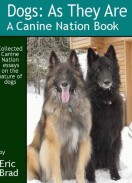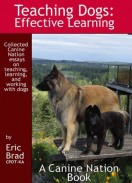 Training a dog can be frustrating. You know what you are trying to help your dog understand; what you want them to learn. You gesture, you wave the food, you call their name, and maybe even cheer-lead them a bit. If they would just pay attention and do the behaviour, you can reward them and the lesson can continue. Unfortunately, the dog isn’t paying the least bit of attention. You’ve seen it. In fact, it’s probably happened to you with your dog. I know that it’s happened to me. But I’ve found a few tricks to keep these little lapses of attention from getting me frustrated and help my dog get back on the training track.
Training a dog can be frustrating. You know what you are trying to help your dog understand; what you want them to learn. You gesture, you wave the food, you call their name, and maybe even cheer-lead them a bit. If they would just pay attention and do the behaviour, you can reward them and the lesson can continue. Unfortunately, the dog isn’t paying the least bit of attention. You’ve seen it. In fact, it’s probably happened to you with your dog. I know that it’s happened to me. But I’ve found a few tricks to keep these little lapses of attention from getting me frustrated and help my dog get back on the training track.
I’ve written before about how training realistically resembles a game of inter-species “Charades” with us humans trying to get the dog to guess the right behaviour so we can reward them. But there is a downside to that analogy. It can be too easy to get stuck in the “rules” of the game. For example, as the trainer, I know that it is training time and that I’m trying to work with my dog, but how does my dog understand why this time is any different from play time or exploring time or even just “I’m not on the job right now” time? There are lots of ways to lose my dog’s focus while I’m training so I’ve devised a few strategies to make the most of my training time.
The value of structure
One of the things I learned very early in my introduction to reward based training was to keep my training sessions short and fun. “Always leave the dog wanting more” was the advice I saw most often in the books I was reading. I don’t remember reading it in those books, but I fell into a good habit of having a very definite structure for my training time with my dog. In the beginning, we always learned new things in our “training room.” If we were in that room, my dog knew that it was time to play that game where she does things and gets rewards. When we were finished, we left that room and went to do other things. It didn’t take long before we started moving our training to different places so I needed to create a different structure for my dog.
Knowing when training starts and when it is over is very important to a dog. This is especially true of a dog being trained with rewards. From my dog’s perspective, we are playing a game of “how can I get dad to give me a reward?” Almost always that comes down to offering me some behaviour or another. If my dog doesn’t know that our training time has ended, she can continue showing me random behaviours with increasing frustration not understanding that “training time” is over for now. So, to manage her expectation, I created some habits, “rituals” if you like, at the beginning and end of our training so that she would know when we were starting and when we were ending.
These “rituals” are what Karen Pryor once called “Informational Cues.” They don’t require my dog to do anything, they just tell her what’s happening. To begin, I normally call my dog over to me and give her a cheerful clap and a “Ready Ready?” By doing this each time we train, she comes to expect that reward-time has started and that being clever and paying attention is likely to pay off. Similarly, when we end a session, I clap cheerfully, show her my empty hands and say “All done!” and move away. It’s her sign that the rewards-bar is now closed and she is free to do what she likes.
Research into canine biology and cognition has yielded some interesting new information in the past few decades. One of these interesting facts is how fast our dogs can process sensory information. For example, our dogs see us move in “slow motion” compared to how we see and they respond far more quickly than we do to sensory information because they do not process information in the complex ways we do. Remarkable abilities, but they also have a significant downside. Humans often take a few seconds to get their thoughts together or decide what to do next. That means they are waiting for us a lot of the time. And that can get boring.
One of the challenges of coaching and teaching students in dog agility is that it is often necessary to give some coaching or instruction to the human. Good human etiquette means that my students want to listen to me but I don’t want them to just turn away from their dog. Imagine talking with someone only to have them turn their back and engage in another conversation before turning back to you. The first few times that happens, you may be able to forgive your friend because, well, these things happen and perhaps that other conversation was important. But rather quickly it grows tiresome. Why can’t your friend just say “I’ll be back in one minute” so that you can use your time the way you want instead of wondering when they might be back?
Lapses in training for whatever reason can lead to ambiguity. Are we still training? Am I free to go? What’s happening? Some dogs may get frustrated, others may get bored, and some will just find something else to do for a while. But that ambiguity turns to frustration when we get angry or upset with our dogs for “drifting away” during training. Some might call it our dog being “a jerk” or “blowing them off.” But the truth is, the dog is coping with their confusion the best way they know how. If they’ve gone off to sniff or wandered away, you’ve lost their interest and the mistake is yours, not theirs.
Staying on track
Having the ability to tell my dog when we are starting and ending training is a great help in reducing confusion and avoiding frustration when we train. But it is just one of several tricks I use to keep us on track during training. Having the ability to set
my dog’s expectations on and off means that if I need to interrupt our training for any reason, I can clap and say “Done for now!” and my dog knows she is free to sniff or lie down or whatever she likes. A quick clap and a “Ready Ready?” tells her that training is back on. I teach that structure trick to students so that I can more easily work with them. They just signal their dogs that they will “be right back” and the dogs remain calm and engaged.
 It is also important for me to attend to that difference in how my dog and I perceive the world. Often a training plan or method won’t work as I expect and I will need to re-think how I want to approach teaching my dog this particular behaviour. It is unfair to make my dog wait while the minutes tick away with no information from me. She deserves to know what’s happening. For that reason, I have a simple rule that if I need to take more than 20 or 30 seconds to change my plan, I either ask for an easy behaviour and end the session or move on to something I have a clearer plan for training. I try to do my re-thinking and re-planning for training away from my dog so she isn’t just waiting around for me.
It is also important for me to attend to that difference in how my dog and I perceive the world. Often a training plan or method won’t work as I expect and I will need to re-think how I want to approach teaching my dog this particular behaviour. It is unfair to make my dog wait while the minutes tick away with no information from me. She deserves to know what’s happening. For that reason, I have a simple rule that if I need to take more than 20 or 30 seconds to change my plan, I either ask for an easy behaviour and end the session or move on to something I have a clearer plan for training. I try to do my re-thinking and re-planning for training away from my dog so she isn’t just waiting around for me.
Preparation plays a large role in how I work with my dogs. I have found that it is always best to know in advance what I would like to accomplish in a training session and come prepared to try things in a certain order and at a brisk pace to keep my dog interested. If that pacing starts to falter or if her performance starts to falter, I need to adjust my expectation lower or be ready to end our session on a good note. We can always do more work later.
Losing my dog’s interest while we are training can be annoying in the moment. It can be frustrating for my dog. But the bigger problem with all of this happens over a much longer period of time. You see, one of the most important factors in reward-based training is my dog’s belief in that system of “you do something for me and I will reward you.” If we lose the plot too often or if my dog feels lost too much of the time, she can start to lose faith in that system. That means that over time it will be harder and harder to keep her interest. Will she expect me to be ready with the rewards or will she expect me to be spaced out and be boring and uncommunicative?
I prefer to keep things fast paced, short, and very consistent so my dog doesn’t have to guess. Being interesting isn’t hard, it just takes a little focus and discipline. And it can pay off for many years down the road!
Until next time, have fun with your dog!
Be sure to check out our Canine Nation ebooks in the Canine Nation store and Dogwise. Join our conversation on Facebook in the Canine Nation Forum!
These Canine Nation ebooks are now available –
Photo credits –
Attentive – Frank Pierson copyright 2012 from Flickr
Sniffing –Jana Reifegerste copyright 2013 from Flickr
Wave – Katie Wheeler copyright 2012 from Flickr






[…] my previous article, Stay Interesting to Your Dog,I talked about the value of creating a system of signals to let your dog know when the “good […]